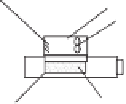Environmental Engineering Reference
In-Depth Information
into a small silver ring. The water then evaporates, cool-
ing the thermocouple junction. This procedure allows for
a more stable reading to be taken over a longer period
of time.
The Peltier psychrometer has an upper range for measur-
ing total suction of about 8000 kPa. This limit is governed
by an ability to condense a drop of water onto the tip of a
thermocouple. The wet-loop psychrometer does not rely on
the condensation of a water droplet and therefore extends
the range over which total suction can be measured. The
upper limit for measuring total suction with the wet-loop
psychrometer is 300,000 kPa.
4.3.2 Chilled-Mirror Psychrometer
The chilled-mirror psychrometer uses a dew-point measure-
ment to determine the total suction in a soil. The measure-
ment is performed under isothermal conditions in a sealed
container. Gee et al., (1992) introduced the chilled-mirror
technique that can be used for the measurement of total suc-
tion in the range from 3000 to 300,000 kPa. This allowed
the measurement of total suction in the mid- to high-suction
range. The device was first introduced as a water activity
meter and later commercialized by Decagon Co.
The chilled-mirror Water PotentiaMeter, WP4, from
Decagon has been studied by several geotechnical re-
searchers (Leong et al., 2003b; Thakur et al., 2006; Agus and
Schanz, 2005; Campbell et al., 2007; Cardoso et al., 2007). A
testing procedure has been set forth in the American Society
Testing and Materials (2008) standard D 6836-02. Some
new features have been added to the chilled-mirror Water
PotentiaMeter to minimize the effect of ambient temperature
fluctuations when making a total-suction measurement. The
new device with the internal temperature control is called
the WP4-T.
Figure 4.73 shows a schematic diagram of a dew-point
Water PotentiaMeter, WP4 (Leong et al., 2003b). The device
consists of a sealed chamber with a fan, a mirror, a photo-
electric cell, and an infrared thermometer. A soil specimen
is placed in a stainless steel or plastic container that has
a diameter of 40 mm. The specimen is then moved into
the chamber on a tray. The specimen thickness may vary
between 1 and 5 mm. The chamber is closed and the soil
specimen is thermodynamically equilibrated with the cham-
ber environment. A fan accelerates the equilibration process.
Figure 4.71
Total suction versus as-compacted water content for
Regina clay (from Krahn and Fredlund, 1972)
of the same soil compacted in the field can be inferred
from the relationships illustrated in Figs. 4.70 and 4.71.
Comparisons between suction measurements using ther-
mocouple psychrometers and suction measurements using
the filter paper technique are shown in Fig. 4.72. The results
indicate reasonably close agreement between suction mea-
surements made using psychrometers or filter paper.
4.3.1.4 Wet-Loop-Type Psychrometers
The wet-loop psychrometer was described by Richards and
Ogata (1958). It differs from the Peltier-type psychrom-
eter in the manner by which the evaporating junction is
wetted. The evaporating junction in the wet-loop psychrom-
eter is mechanically wetted by placing a drop of water
Temperature
sensor
Fan
Mirror and photodetector
Sealed chamber
Soil sample
Figure 4.72
Comparison of psychrometer and filter paper mea-
surements of total suction on compacted silty sand (after Daniel
et al., 1981).
Figure 4.73
Schematic diagram of chilled-mirror WP4 Water
PotentiaMeter (after Leong et al., 2003).














Search WWH ::

Custom Search